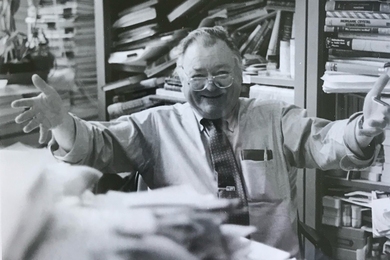MIT officials addressed neighborhood concerns about the new undergraduate residence hall planned for Vassar Street at a meeting at the Morse School in Cambridgeport last Thursday night.
The meeting, co-hosted by the Institute and the City of Cambridge's Community Development Department, was attended by about 50 people, including 30 residents of the area and several MIT students. It was requested by City Councilors Henrietta Davis and Kathy Born, who also attended.
The residence hall site is only 90 feet deep, forcing the designers to create a long narrow long building 10 stories high, 54 feet wide and 380 feet long. It will house 350 students, a housemaster, assistant housemaster, five visiting faculty and 10 graduate resident assistants.
Window walls (a square block of nine two-foot square windows in a single room) are designed to provide light in the neighborhood at night and also a source of ventilation for an energy-conscious building that will not be air-conditioned. The windows are recessed a foot from the outside wall to permit maximum sunshine in winter and minimal heat from the sun in summer.
Photographs of the building model from 11 neighborhood perspectives were presented to demonstrate how it would look from these points. A "nighttime" photo of the model showed the outside effect of the lighted window walls.
Ms. Davis had wondered whether the proposed anodized aluminum panels that will cover the concrete building would cause glare and reflection problems. Tim Bade of Steven Holl Associates, architect for the project, passed around a sample panel, noting that it had the same reflective quality as the anodized aluminum girders of Rotch Library.
After seeing the sample, Ms. Davis asked if the building might become a dull color because the panel was insufficiently reflective. Mr. Bade replied that it was reflective enough to make it appear to change colors but would not create the sensation of a mirror like the John Hancock Tower does in Copley Square.
As for concerns that the building would overshadow Fort Washington Park, Charles Sullivan, executive director of the Cambridge Historic Commission, noted that the park was created by a developer in the 1850s and designed to be "enclosed" by residences. "The impact of this site on Fort Washington Park is quite minimal," he said.
MIT Director of Planning O. Robert Simha noted that since 1992, MIT has worked diligently to improve the Cambridgeport neighborhood, citing the renovation of 640 Memorial Drive, the pedestrian crossing with gates across the railroad tracks to Fort Washington Park, and the creation of low- and moderate-income housing and open space at the University Park development on land leased by MIT to the developer, Forest City. He said MIT intends to remake Vassar Street into a pedestrian-friendly thoroughfare.
Associate Professor of History Anne McCants, housemaster at Green Hall and chair of the Founders Group for the new residence hall, noted that her children are in public school in Cambrideport and she expected that the housemasters and other adults moving into the dormitory would have children and would become part of the Cambridgeport community. She said the Founders Group made up of students, faculty and housemasters were enthusiastic about the plans.
"Students like it," she said. "It's funky [in its design]." She added that many students "are eager to have more housing opportunities near campus in Cambridge."
Jeffrey Roberts, a sophomore in urban studies and planning who now lives in Baker House, said he hoped the new residence would be finished in time for his senior year. It is scheduled to open in September 2001.
"It's a very exciting building. The inside is very spacious," he said, adding that the building would "provide an opportunity for students to become closer to the Cambridgeport neighborhood."
A Cambridgeport resident said the design looked like a jail. Mr. Roberts responded that students liked the window design, which provides a wall of light. He noted that there is a larger expanse of window wall in double rooms.
William Cavellini, an MIT alumnus and longtime Cambridgeport resident, asked MIT to try to keep future buildings at a relatively low height.
A version of this article appeared in MIT Tech Talk on February 2, 2000.





